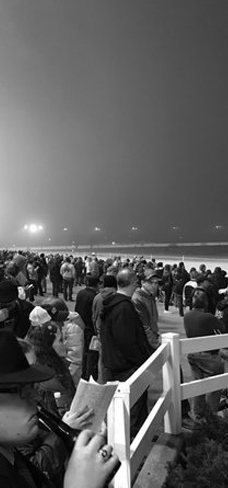 |
|
| Balmoral's Farewell and Its Vague Success |
| |
|
| |
Ray Cotolo
January 5, 2016 |
| |
|
Either from the simulcast feed or the grandstands of Balmoral Park, people could see the massive
crowd that poured in to watch the final events from the racetrack. Plagued by corruption from
criminal former governor Rod Blagojevich, Balmoral was forced to close down after being forced to
pay a $77.8 million settlement to the state's casinos. The settlement was prompted by
behind-closed-doors negotiations between Balmoral president John Johnston and Blagojevich, which
Johnston offerred a $100,000 payment to Blagojevich if he extended a levy upon the state's casinos,
allowing Balmoral's and Maywood's purses to increase, as well as the thoroughbred tracks Arlington
Park and Hawthorne Racecourse.
|
| |
|
After filing for Chapter 11 bankruptcy, Balmoral, along with Maywood (which held its final race
months ago), struggled to remain open. Because of this, the Racing Board decided to shut down the
tracks and awarded all of Illinois' harness racing dates for next year to Hawthorne Racecourse.
Many reports claim that the racetracks may have been able to stay afloat if the state passed
legislations legalizing slots at racetracks, but amid the scandal, was debatable.
|
| |
|
Balmoral's final card drew many sentimental feelings. Reminders of the track's history and legacy
were advertised heavily; being labeled as the "Historic Balmoral Park" in some press releases.
The track is certainly deserving of the title, having conducted races since 1926. Now, nearly 90
years later, that legacy ended.
|
| |
|
Heading into the final evening, Balmoral had hit a peculiar peak. For a racetrack with lackluster
purses and horses, they managed to average around $1,000,000 in handle a racenight, most coming off
track since attendance numbers were usually below 2,000. With that abnormal statistic, the track
also continually fluctuated between eight and nine horses per race since August.
|
| |
|
Fast forward to the final month of racing and Balmoral continues to handle big amounts. On their
December 5 card, they handled $1,055,365 with an average of 9.4 horses per race over twelve races.
They followed the next two weeks with handle numbers of $885,859 and $904,776 respectively, also
maintaining an average field size of about 9.6 horses. Presumably, these numbers were due heavily
to off-track bettors.
|
| |
|
With all of this basic information in my mind, I was amazed to see the amount of heads filling the
stands on Balmoral's final evening. Despite rain and fog, 6,590 turned out for one more glimpse of
the Crete racetrack. That number is about more than half of Balmoral's record attendance of 11,494
set in 1990. However, with that crowd, Balmoral handled $1,347,100 over 12 races, with about 9.3
horses per race.
|
|
| |
Crowd observing the final races at Balmoral Park.
Courtesy: Frank Comber
|
|
Seeing those numbers, I wanted to understand the specifics around what generated those figures. To
me, seeing 6,500 people in attendance makes me assume that the track did really well that night,
but seeing $1.3 million in handle makes me question that. For example, Balmoral handled $1,146,279
on May 16, $1,053,144 on July 18, and $916,646 on November 28, the Saturday following Thanksgiving.
In that grouping, $1.3 million seems like a minor improvement from an average Saturday night. Yet,
it could also mean a massive improvement since they handled nearly $400,000 more than the previous
holiday Saturday. Compared to the same race date the previous year (December 27), Balmoral handled
about $300,000 more on their closing night, and their Thanksgiving Saturday program handled about
$100,000 less this year.
|
| |
|
Those average figures make it hard for me to interpret whether or not Balmoral actually had a
successful evening. Now, by successful, I'm referring to an improvement from their average due to
special circumstances. On their Super Night this year, which features about $1 million in purses
for Illinois-bred horses, Balmoral handled $1,461,943 with a crowd of around 6,000 on track. It's
reasonable that their biggest night would outperform their final night, so in that sense,
stakes-night figures on an average race card makes it a success.
|
| |
|
Yet, it's hard to call the night a success when the figures are only slightly better than the
average. Sure, seeing 30 percent growth is a positive figure. But, compared to last year's Super
Night, the final card at Balmoral Park handled about $300,000 less. Perhaps the aspect of the
figures that blurs the line the greatest are the attendance numbers, as instinct tells me that more
people means more money, but my expectations are maybe more substantial than in actuality.
|
| |
|
Exposure matters in racing, but it matters so that it influences betting on the races. These figures
can become guides in understanding the relationship between the attendee and wagering, hence my
exploration of the numbers. Even though it's a secondary effect of bringing people to the races,
gambling is what matters. Obviously, the closing of a staple like Balmoral would attract people to
the premises, but that element makes the potential handle and attendance hard to calculate. So,
whether or not Balmoral had a successful evening, they performed slightly above average and had
stakes-night level attendance on a cold and rainy night in December.
|
| |
|
In the end, through analyzing all the figures, Balmoral is no more, and John Johnston put it best:
|
| |
|
"There's no winner in all of this."
|
| |
| Ray Cotolo, long time follower of the harness racing industry,
is a presenter on North American Harness
Update. |
|
